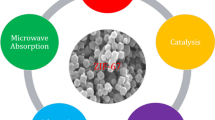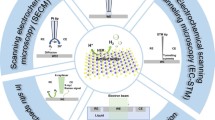Abstract
Many transition metal sulfides and phosphides are susceptible to surface oxidation under ambient conditions. The formed surface oxidation layer, which is likely to further restructure under reaction conditions, alters the chemical properties of the pristine material but has not been well studied. In this work, we for the first time use X-ray photoelectron spectroscopy to quantify the natural surface oxidation of transition metal phosphide and sulfide nanoparticles and employ a simplified Deal-Grove model to analyze the kinetics. We show that CoS2 oxidizes faster than CoS whereas CoP2 is more difficult to oxidize compared to CoP, and there exists an inverse correlation between the surface oxidation rate and the Co-S/P distance in the pristine structure. More inclusive investigation unveils different types of surface oxidation behavior: CoS, NiS and FeS are limited by their reactivity with oxygen; CoS2 is the most reactive and its oxidation is governed by oxygen diffusion; CoP2 is influenced by both reactivity and diffusion; CoP, Ni2P, Cu3P and MoP exhibit high initial oxidation degrees and the kinetics are not well-defined; MoS2 is largely stable against oxidation.

Similar content being viewed by others
Change history
03 July 2021
The Table of Content figure was unfortunately misrepresented in this article.
05 July 2021
An Erratum to this paper has been published: https://doi.org/10.1007/s12274-021-3296-0
References
Geng, P. B.; Zheng, S. S.; Tang, H.; Zhu, R. M.; Zhang, L.; Cao, S.; Xue, H. G.; Pang, H. Transition metal sulfides based on graphene for electrochemical energy storage. Adv. Energy Mater. 2018, 8, 1703259.
Joo, J.; Kim, T.; Lee, J.; Choi, S. I.; Lee, K. Morphology-controlled metal sulfides and phosphides for electrochemical water splitting. Adv. Mater. 2019, 31, 1806682.
Callejas, J. F.; Read, C. G.; Roske, C. W.; Lewis, N. S.; Schaak, R. E. Synthesis, characterization, and properties of metal phosphide catalysts for the hydrogen-evolution reaction. Chem. Mater. 2016, 28, 6017–6044.
Guo, Y. N.; Park, T.; Yi, J. W.; Henzie, J.; Kim, J.; Wang, Z. L.; Jiang, B.; Bando, Y.; Sugahara, Y.; Tang, J. et al. Nanoarchitectonics for transition-metal-sulfide-based electrocatalysts for water splitting. Adv. Mater. 2019, 31, 1807134.
Li, X. L.; Liu, W.; Zhang, M. Y.; Zhong, Y. R.; Weng, Z.; Mi, Y. Y.; Zhou, Y.; Li, M.; Cha, J. J.; Tang, Z. Y. et al. Strong metal-phosphide interactions in core-shell geometry for enhanced electrocatalysis. Nano Lett. 2017, 17, 2057–2063.
Liu, W.; Hu, E. Y.; Jiang, H.; Xiang, Y. J.; Weng, Z.; Li, M.; Fan, Q.; Yu, X. Q.; Altman, E. I.; Wang, H. L. A highly active and stable hydrogen evolution catalyst based on pyrite-structured cobalt phosphosulfide. Nat. Commun. 2016, 7, 10771.
Chen, Y. N.; Xu, S. M.; Zhu, S. Z.; Jacob, R. J.; Pastel, G.; Wang, Y. B.; Li, Y. J.; Dai, J. Q.; Chen, F. J.; Xie, H. et al. Millisecond synthesis of CoS nanoparticles for highly efficient overall water splitting. Nano Res. 2019, 12, 2259–2267.
Zhao, X. J.; Luo, D.; Wang, Y.; Liu, Z. H. Reduced graphene oxide-supported CoP nanocrystals confined in porous nitrogen-doped carbon nanowire for highly enhanced lithium/sodium storage and hydrogen evolution reaction. Nano Res. 2019, 12, 2872–2880.
Saadi, F. H.; Carim, A. I.; Verlage, E.; Hemminger, J. C.; Lewis, N. S.; Soriaga, M. P. CoP as an acid-stable active electrocatalyst for the hydrogen-evolution reaction: Electrochemical synthesis, interfacial characterization and performance evaluation. J. Phys. Chem. C 2014, 118, 29294–29300.
Pan, Y.; Lin, Y.; Chen, Y. J.; Liu, Y. Q.; Liu, C. G. Cobalt phosphide-based electrocatalysts: Synthesis and phase catalytic activity comparison for hydrogen evolution. J. Mater. Chem. A 2016, 4, 4745–4754.
Popczun, E. J.; Read, C. G.; Roske, C. W.; Lewis, N. S.; Schaak, R. E. Highly active electrocatalysis of the hydrogen evolution reaction by cobalt phosphide nanoparticles. Angew. Chem., Int. Ed. 2014, 53, 5427–5430.
Tian, J. Q.; Liu, Q.; Asiri, A. M.; Sun, X. P. Self-supported nanoporous cobalt phosphide nanowire arrays: An efficient 3D hydrogen-evolving cathode over the wide range of pH 0–14. J. Am. Chem. Soc. 2014, 136, 7587–7590.
Ryu, J.; Jung, N.; Jang, J. H.; Kim, H. J.; Yoo, S. J. In situ transformation of hydrogen-evolving CoP nanoparticles: Toward efficient oxygen evolution catalysts bearing dispersed morphologies with co-oxo/hydroxo molecular units. ACS Catal. 2015, 5, 4066–4074.
Jin, S. Are metal chalcogenides, nitrides, and phosphides oxygen evolution catalysts or bifunctional catalysts? ACS Energy Lett. 2017, 2, 1937–1938.
Lee, M.; Oh, H. S.; Cho, M. K.; Ahn, J. P.; Hwang, Y. J.; Min, B. K. Activation of a Ni electrocatalyst through spontaneous transformation of nickel sulfide to nickel hydroxide in an oxygen evolution reaction. Appl. Catal. B Environ. 2018, 233, 130–135.
Zuo, Y.; Liu, Y. P.; Li, J. S.; Du, R. F.; Han, X.; Zhang, T.; Arbiol, J.; Divins, N. J.; Llorca, J.; Guijarro, N. et al. In situ electrochemical oxidation of Cu2S into CuO nanowires as a durable and efficient electrocatalyst for oxygen evolution reaction. Chem. Mater. 2019, 31, 7732–7743.
Gan, Q.; Wu, Z. S.; Li, X. L.; Liu, W.; Wang, H. L. Structure and electrocatalytic reactivity of cobalt phosphosulfide nanomaterials. Top. Catal. 2018, 61, 958–964.
Wu, Z. S.; Li, X. L.; Liu, W.; Zhong, Y. R.; Gan, Q.; Li, X. M.; Wang, H. L. Materials chemistry of iron phosphosulfide nanoparticles: Synthesis, solid state chemistry, surface structure, and electrocatalysis for the hydrogen evolution reaction. ACS Catal. 2017, 7, 4026–4032.
Pető, J.; Ollár, T.; Vancsó, P.; Popov, Z. I.; Magda, G. Z.; Dobrik, G.; Hwang, C.; Sorokin, P. B.; Tapasztó, L. Spontaneous doping of the basal plane of MoS2 single layers through oxygen substitution under ambient conditions. Nat. Chem. 2018, 10, 1246–1251.
Zhang, Y.; Gao, L.; Hensen, E. J. M.; Hofmann, J. P. Evaluating the stability of Co2P electrocatalysts in the hydrogen evolution reaction for both acidic and alkaline electrolytes. ACS Energy Lett. 2018, 3, 1360–1365.
Wu, Z. S.; Gan, Q.; Li, X. L.; Zhong, Y. R.; Wang, H. L. Elucidating surface restructuring-induced catalytic reactivity of cobalt phosphide nanoparticles under electrochemical conditions. J. Phys. Chem. C 2018, 122, 2848–2853.
Wu, Z. S.; Huang, L.; Liu, H.; Wang, H. L. Element-specific restructuring of anion- and cation-substituted cobalt phosphide nanoparticles under electrochemical water-splitting conditions. ACS Catal. 2019, 9, 2956–2961.
Zhong, Y. R.; Yin, L. C.; He, P.; Liu, W.; Wu, Z. S.; Wang, H. L. Surface chemistry in cobalt phosphide-stabilized lithium-sulfur batteries. J. Am. Chem. Soc. 2018, 140, 1455–1459.
Yang, Y. X.; Zhong, Y. R.; Shi, Q. W.; Wang, Z. H.; Sun, K. N.; Wang, H. L. Electrocatalysis in lithium sulfur batteries under lean electrolyte conditions. Angew. Chem., Int. Ed. 2018, 57, 15549–15552.
Mi, Y. Y.; Liu, W.; Li, X. L.; Zhuang, J. L.; Zhou, H. H.; Wang, H. L. High-performance Li–S battery cathode with catalyst-like carbon nanotube-MoP promoting polysulfide redox. Nano Res. 2017, 10, 3698–3705.
Vasiliy, T. Materials Science International Team, M. Phase Diagarm of the Co-S Binary System: Datasheet from Msi Eureka in Springer-materials[Online]. Stuttgart: MSI, Materials Science International Services GmbH. https://materials.springer.com/msi/phase-diagram/docs/sm_msi_r_10_011155_01_full_LnkDia0.
Wang, H. L.; Liang, Y. Y.; Li, Y. G.; Dai, H. J. Co1–XS–graphene hybrid: A high-performance metal chalcogenide electrocatalyst for oxygen reduction. Angew. Chem., Int. Ed. 2011, 50, 10969–10972.
Deal, B. E.; Grove, A. S. General relationship for the thermal oxidation of silicon. J. Appl. Phys. 1965, 36, 3770–3778.
Acknowledgements
This work is partially supported by the Sloan Research Fellowship. L. H. and H. L. acknowledge graduate student exchange fellowships from the China Scholarship Council.
Author information
Authors and Affiliations
Corresponding author
Electronic Supplementary Material
Rights and permissions
About this article
Cite this article
Wu, Z., Huang, L., Liu, H. et al. Surface oxidation of transition metal sulfide and phosphide nanomaterials. Nano Res. 14, 2264–2267 (2021). https://doi.org/10.1007/s12274-020-3219-5
Received:
Revised:
Accepted:
Published:
Issue Date:
DOI: https://doi.org/10.1007/s12274-020-3219-5




